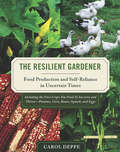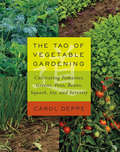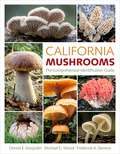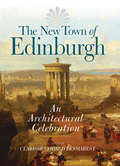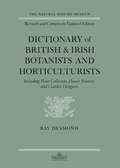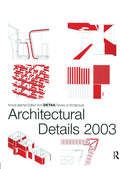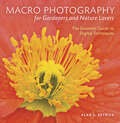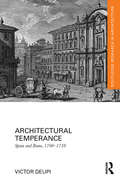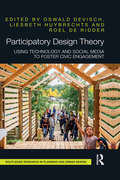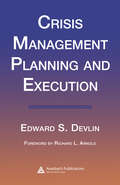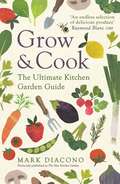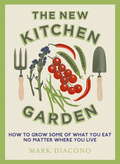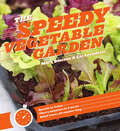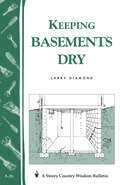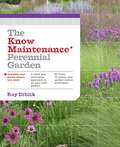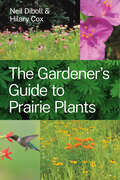- Table View
- List View
Calm
by Sally DenningIn recent times, many of us have spent more time at home than ever before. Creating a home that instills a sense of calm will cocoon and protect us from the outside world, create a sense of wellbeing and make us feel truly nurtured. Calm will help you create a restful, restorative interior that draws you in and makes your shoulders drop the moment you walk through the door. Sally Denning first explores the essential foundations of a tranquil, comforting home: calming and harmonious colours, textiles, pattern, lighting and decorative elements. She goes on to explore a mix of accessible real-life homes, ranging from city homes to country houses, new builds, flats/apartments, beach houses and more. The spaces may be different, but they all share one thing: a timeless, soothing and restful atmosphere that is a pleasure to come home to.
The Resilient Gardener: Food Production and Self-Reliance in Uncertain Times
by Carol DeppeScientist/gardener Carol Deppe combines her passion for organic gardening with newly emerging scientific information from many fields — resilience science, climatology, climate change, ecology, anthropology, paleontology, sustainable agriculture, nutrition, health, and medicine. In the last half of The Resilient Gardener, Deppe extends and illustrates these principles with detailed information about growing and using five key crops: potatoes, corn, beans, squash, and eggs. In this book you’ll learn how to: •Garden in an era of unpredictable weather and climate change •Grow, store, and use more of your own staple crops •Garden efficiently and comfortably (even if you have a bad back) •Grow, store, and cook different varieties of potatoes and save your own potato seed •Grow the right varieties of corn to make your own gourmet-quality fast-cooking polenta, cornbread, parched corn, corn cakes, pancakes and even savory corn gravy •Make whole-grain, corn-based breads and cakes using the author’s original gluten-free recipes involving no other grains, artificial binders, or dairy products •Grow and use popbeans and other grain legumes •Grow, store, and use summer, winter, and drying squash •Keep a home laying flock of ducks or chickens; integrate them with your gardening, and grow most of their feed. The Resilient Gardener is both a conceptual and a hands-on organic gardening book, and is suitable for vegetable gardeners at all levels of experience. Resilience here is broadly conceived and encompasses a full range of problems, from personal hard times such as injuries, family crises, financial problems, health problems, and special dietary needs (gluten intolerance, food allergies, carbohydrate sensitivity, and a need for weight control) to serious regional and global disasters and climate change. It is a supremely optimistic as well as realistic book about how resilient gardeners and their vegetable gardens can flourish even in challenging times and help their communities to survive and thrive through everything that comes their way — from tomorrow through the next thousand years. Organic gardening, vegetable gardening, self-sufficiency, subsistence gardening, gluten-free living.
The Tao of Vegetable Gardening: Cultivating Tomatoes, Greens, Peas, Beans, Squash, Joy, and Serenity
by Carol DeppeThe Tao of Vegetable Gardening explores the practical methods as well as the deeper essence of gardening. In her latest book, groundbreaking garden writer Carol Deppe (The Resilient Gardener, Breed Your Own Vegetable Varieties) focuses on some of the most popular home garden vegetables—tomatoes, green beans, peas, and leafy greens—and through them illustrates the key principles and practices that gardeners need to know to successfully plant and grow just about any food crop. Deppe’s work has long been inspired and informed by the philosophy and wisdom of Tao Te Ching, the 2,500-year-old work attributed to Chinese sage Lao Tzu and the most translated book in the world after the Bible. The Tao of Vegetable Gardening is organized into chapters that echo fundamental Taoist concepts: Balance, Flexibility, Honoring the Essential Nature (your own and that of your plants), Effortless Effort, Non-Doing, and even Non-Knowing. Yet the book also offers a wealth of specific and valuable garden advice on topics as diverse as: • The Eat-All Greens Garden, a labor- and space-efficient way to provide all the greens a family can eat, freeze, and dry—all on a tiny piece of land suitable for small-scale and urban gardeners. • The growing problem of late blight and the future of heirloom tomatoes—and what gardeners can do to avoid problems, and even create new resistant varieties. • Establishing a Do-It-Yourself Seed Bank, including information on preparing seeds for long-term storage and how to “dehybridize” hybrids. • Twenty-four good places to not plant a tree, and thirty-seven good reasons for not planting various vegetables. Designed for gardeners of all levels, from beginners to experienced growers, The Tao of Vegetable Gardening provides a unique frame of reference: a window to the world of nature, in the garden and in ourselves.
Fifty Chairs that Changed the World: Design Museum Fifty (Design Museum Fifty)
by Design Museum Enterprise LimitedEverything around us is designed and the word 'design' has become part of our everyday experience. But how much do we know about it? Fifty Chairs That Changed the World imparts that knowledge listing the top 50 chairs that have made a substantial impact in the world of British design today. From Thonet's 1870 Side Chair to Konstantin Grcic's Chair_One, each entry offers a short appraisal to explore what has made their iconic status and the designers that give them a special place in design history.
Landscape Architecture Documentation Standards: Principles, Guidelines, and Best Practices
by Design WorkshopSUPERB EXECUTION RELIES UPON RIGOROUS PROJECT DOCUMENTATION A project will only be built as well as it is documented. This publication focuses on the key documentation needs of the landscape architectural design and construction documentation process. That includes both "design documentation" and "construction documentation" as well as all that which occurs in the transition from one phase to the other. Documentation requirements include those components necessary to explore and define design intent, logic, physical proposals, and ultimately, the specific components included within construction and bid documents. Discover how proper documentation facilitates every stage of the design process from pre-planning to construction, and leads to a highly resolved built outcome. Understand the principles behind these documentation practices. Implement best practices specific to each documentation phase and drawing, from title block and cover sheet design to soil plans and plant protection. Organize keynoting systems, cross-referencing and interdisciplinary coordination amongst multiple consultants and vendors. Study sample project documents from a leading landscape architecture firm to better understand the elements and benefits of complete and well-coordinated project documentation. These standards have been time-tested by over 150 designers at the industry leading landscape architecture firm Design Workshop, reflecting a range of project types, including parks, streetscapes, urban spaces and over-structure construction. This guide shares the methods behind the success, to facilitate exceptional built outcomes through principled documentation practices.
Landscape Architecture Documentation Standards: Principles, Guidelines, and Best Practices
by Design WorkshopSUPERB EXECUTION RELIES UPON RIGOROUS PROJECT DOCUMENTATION A project will only be built as well as it is documented. This publication focuses on the key documentation needs of the landscape architectural design and construction documentation process. That includes both "design documentation" and "construction documentation" as well as all that which occurs in the transition from one phase to the other. Documentation requirements include those components necessary to explore and define design intent, logic, physical proposals, and ultimately, the specific components included within construction and bid documents. Discover how proper documentation facilitates every stage of the design process from pre-planning to construction, and leads to a highly resolved built outcome. Understand the principles behind these documentation practices. Implement best practices specific to each documentation phase and drawing, from title block and cover sheet design to soil plans and plant protection. Organize keynoting systems, cross-referencing and interdisciplinary coordination amongst multiple consultants and vendors. Study sample project documents from a leading landscape architecture firm to better understand the elements and benefits of complete and well-coordinated project documentation. These standards have been time-tested by over 150 designers at the industry leading landscape architecture firm Design Workshop, reflecting a range of project types, including parks, streetscapes, urban spaces and over-structure construction. This guide shares the methods behind the success, to facilitate exceptional built outcomes through principled documentation practices.
California Mushrooms: The Comprehensive Identification Guide
by Dennis E. Desjardin Michael G. Wood Frederick A. StevensCalifornia Mushrooms is a comprehensive guide, providing information on when and where to find mushrooms; guidelines on how to collect and identify mushrooms; keys to species; and overviews of nomenclature and taxonomy, morphology and phylogeny, fungal ecology, biology, and mushroom toxins.
The New Town of Edinburgh: An Architectural Celebration
by Clarisse Godard DesmarestThis collection of innovative essays celebrates the New Town of Edinburgh over the 250 years since its original creation. The contributing authors discuss the intellectual, economic and political contexts which provided the impetus for the city of Edinburgh to expand north of the Old Town, and analyse the New Town’s unique architectural status in terms of its size, monumentality and degree of preservation. For centuries, Scotland has pursued innovation, improvement, commerce and contact with England and the Continent; and since medieval times it has been an urbanising land of planned towns. This book reflects on the constantly changing dialogue between Edinburgh’s Old and New Towns, from the eighteenth century to the present time, as the city became increasingly commercialised. It also compares Edinburgh’s New Town with more recent new towns elsewhere, notably nineteenth-century Dunedin in New Zealand and Scotland’s planned new-town movement of the twentieth century. The age of conservation is another of the central themes.
Dictionary Of British And Irish Botantists And Horticulturalists Including plant collectors, flower painters and garden designers
by Ray DesmondOver the past four centuries botanists and gardeners in the British Isles have gathered, maintained and propagated many varying species of plants. Their work has been documented in innumerable books and articles which are often difficult to trace. The Dictionary of British and Irish Botanists and Horticulturalists represents a time-saving reference source for those who wish to discover more about the lives and achievements of the horticulturalists listed. The dictionary's utility comes not only from indicating the major publications of the named authors, but also the location of their herbaria and manuscripts.; The previous 1977 edition of the Dictionary has for many years been a much used source of information for botanists, botanic artists and archivists. In this revised edition the scope has been expanded to include among its 13,000 entries flower painters in addition to botanical artists over 1400 entries and, for the first time, garden designers.; Finally the Dictionary should have international appeal since so many botanists and gardeners worked on collective plants overseas, in particular in North America and the British Commonwealth.; Each entry gives, wherever possible, details of dates and places of birth and death, educational qualifications, professional posts, honours and awards, publications, location of plant collections, manuscripts, drawings and portraits. Its main function, however, is to provide further biographical references to books and periodicals. Comprehensive classified indices facilitate access by professions and activities, countries, and plant interests.
Dictionary Of British And Irish Botantists And Horticulturalists Including plant collectors, flower painters and garden designers
by Ray DesmondOver the past four centuries botanists and gardeners in the British Isles have gathered, maintained and propagated many varying species of plants. Their work has been documented in innumerable books and articles which are often difficult to trace. The Dictionary of British and Irish Botanists and Horticulturalists represents a time-saving reference source for those who wish to discover more about the lives and achievements of the horticulturalists listed. The dictionary's utility comes not only from indicating the major publications of the named authors, but also the location of their herbaria and manuscripts.; The previous 1977 edition of the Dictionary has for many years been a much used source of information for botanists, botanic artists and archivists. In this revised edition the scope has been expanded to include among its 13,000 entries flower painters in addition to botanical artists over 1400 entries and, for the first time, garden designers.; Finally the Dictionary should have international appeal since so many botanists and gardeners worked on collective plants overseas, in particular in North America and the British Commonwealth.; Each entry gives, wherever possible, details of dates and places of birth and death, educational qualifications, professional posts, honours and awards, publications, location of plant collections, manuscripts, drawings and portraits. Its main function, however, is to provide further biographical references to books and periodicals. Comprehensive classified indices facilitate access by professions and activities, countries, and plant interests.
Architectural Details 2003
by Detail MagazineThis is a compilation of the full year's information, including: the "Discussion" section, where well-known architects and critics as well as specialist authors and architectural historians articulate their views; the "Documentation" section containing an analysis of selected projects, in which buildings from around the world are covered in depth; and the "Technology" section where the specific theme of each issue of the magazine is treated in greater depth. Along with these are illustrations of the high standards that Detail is known for, where all plan drawings are true to scale and have been approved by the architects, planners and engineers responsible for the original design.This annual sourcebook is a beautiful record, not only of the year's Detail publication, but of some of the best, and most innovative contemporary architecture
Architectural Details 2003
by Detail MagazineThis is a compilation of the full year's information, including: the "Discussion" section, where well-known architects and critics as well as specialist authors and architectural historians articulate their views; the "Documentation" section containing an analysis of selected projects, in which buildings from around the world are covered in depth; and the "Technology" section where the specific theme of each issue of the magazine is treated in greater depth. Along with these are illustrations of the high standards that Detail is known for, where all plan drawings are true to scale and have been approved by the architects, planners and engineers responsible for the original design.This annual sourcebook is a beautiful record, not only of the year's Detail publication, but of some of the best, and most innovative contemporary architecture
Macro Photography for Gardeners and Nature Lovers: The Essential Guide to Digital Techniques
by Alan L. DetrickGardeners and nature lovers delight in taking pictures—especially close-ups of flowers, butterflies, and insects. And though advances in digital camera technology have made taking, storing, and sharing photos easier than ever, taking top-quality pictures requires familiarity with both digital technology and the general principles of photography. Macro Photography for Gardeners and Nature Lovers provides exactly the information that aspiring photographers—no matter their level of skill—need to take their photos to the next level. Clear and concise chapters cover the basics of macro (close-up) photography, explain the features of current digital single-lens reflex cameras, show the many ways images can be composed, and share tips on digital effects, storage, and manipulation of imagery. Throughout the text, helpful tips, definitions, exercises, and case studies serve to demystify digital photography. Each lesson is supported by examples of the author's stunning photography. Whether taking photos of flowers and insects, compiling a photographic record of your garden, or simply sharing beautiful images with friends and family, everyone can become accomplished photographers of the world's small-scale wonders.
Architectural Temperance: Spain and Rome, 1700-1759 (Routledge Research in Architecture)
by Victor DeupiArchitectural Temperance examines relations between Bourbon Spain and papal Rome (1700-1759) through the lens of cultural politics. With a focus on key Spanish architects sent to study in Rome by the Bourbon Kings, the book also discusses the establishment of a program of architectural education at the newly founded Real Academia de Bellas Artes de San Fernando in Madrid. Victor Deupi explores why a powerful nation like Spain would temper its own building traditions with the more cosmopolitan trends associated with Rome; often at the expense of its own national and regional traditions. Through the inclusion of previously unpublished documents and images that shed light on the theoretical debates which shaped eighteenth-century architecture in Rome and Madrid, Architectural Temperance provides readers with new insights into the cultural history of early modern Spain.
Architectural Temperance: Spain and Rome, 1700-1759 (Routledge Research in Architecture)
by Victor DeupiArchitectural Temperance examines relations between Bourbon Spain and papal Rome (1700-1759) through the lens of cultural politics. With a focus on key Spanish architects sent to study in Rome by the Bourbon Kings, the book also discusses the establishment of a program of architectural education at the newly founded Real Academia de Bellas Artes de San Fernando in Madrid. Victor Deupi explores why a powerful nation like Spain would temper its own building traditions with the more cosmopolitan trends associated with Rome; often at the expense of its own national and regional traditions. Through the inclusion of previously unpublished documents and images that shed light on the theoretical debates which shaped eighteenth-century architecture in Rome and Madrid, Architectural Temperance provides readers with new insights into the cultural history of early modern Spain.
Participatory Design Theory: Using Technology and Social Media to Foster Civic Engagement
by Oswald Devisch Liesbeth Huybrechts Roel De RidderIn recent years, many countries all over Europe have witnessed a demand for a more direct form of democracy, ranging from improved clarity of information to being directly involved in decision-making procedures. Increasingly, governments are putting citizen participation at the centre of their policy objectives, striving for more transparency, to engage and empower local individuals and communities to collaborate on public projects and to encourage self-organization. This book explores the role of participatory design in keeping these participatory processes public. It addresses four specific lines of enquiry: how can the use and/or development of technologies and social media help to diversify, to coproduce, to interrupt and to document democratic design experiments? Aimed at researchers and academics in the fields of urban planning and participatory design, this book includes contributions from a range of experts across Europe including the UK, Belgium, the Netherlands, Italy, Denmark, Austria, Spain, France, Romania, Hungary and Finland.
Participatory Design Theory: Using Technology and Social Media to Foster Civic Engagement
by Oswald Devisch Liesbeth Huybrechts Roel De RidderIn recent years, many countries all over Europe have witnessed a demand for a more direct form of democracy, ranging from improved clarity of information to being directly involved in decision-making procedures. Increasingly, governments are putting citizen participation at the centre of their policy objectives, striving for more transparency, to engage and empower local individuals and communities to collaborate on public projects and to encourage self-organization. This book explores the role of participatory design in keeping these participatory processes public. It addresses four specific lines of enquiry: how can the use and/or development of technologies and social media help to diversify, to coproduce, to interrupt and to document democratic design experiments? Aimed at researchers and academics in the fields of urban planning and participatory design, this book includes contributions from a range of experts across Europe including the UK, Belgium, the Netherlands, Italy, Denmark, Austria, Spain, France, Romania, Hungary and Finland.
Crisis Management Planning and Execution
by Edward S. DevlinCrisis management planning refers to the methodology used by executives to respond to and manage a crisis and is an integral part of a business resumption plan. Crisis Management Planning and Execution explores in detail the concepts of crisis management planning, which involves a number of crises other than physical disaster. Defining th
Grow & Cook: The Ultimate Kitchen Garden Guide
by Mark DiaconoThe content of this book originally appeared in The New Kitchen Garden, published in 2015. 'An endless selection of delicious produce you can plant, grow and then cook with.' Raymond BlancCreate your own delicious edible garden at home!More and more people are being inspired to grow a little of what they eat at home. But while starting your own kitchen garden may seem like a daunting task at first, Grow & Cook makes it easy.Award-winning author and gardener, Mark Diacono, has distilled years of knowledge into this pocket-sized book. Whether you are new to gardening and only have a small window box or you are much more experienced with the space to experiment, this user-friendly handbook will inspire and help you. Mark is here to show you that there are plenty of options for everyone and lots of exciting new varieties to discover.Each variety in the book includes a wealth of information on when to sow, growing tips, potential problems, harvesting and plenty more. There are hundreds of varieties to pick from that can be grown and then used in your kitchen. Mark separates the growing guides into three groups:* Vegetables* Fruit & Nuts* Herbs & SpicesWhatever you choose to grow should suit your lifestyle. You might prefer something tough and sturdy that doesn't need too much love or time commitment, or you might get pleasure from the steady graft of looking after your veg patch. Whichever your circumstances, your kitchen garden should bring you joy both in the growing process and then in the kitchen.Grow & Cook is the essential pocket guide for modern gardeners.
Grow & Cook: The Ultimate Kitchen Garden Guide
by Mark DiaconoWhether you are taking your first steps in growing some of what you eat, or experienced and looking for inspiration, ideas and some new plants to grow, The New Kitchen Garden is for you. Inspired by a range of gardeners growing food on allotments, on rooftops, in container gardens and in other edible spaces, many of them urban, Mark shows you the full exciting breadth of what a kitchen garden can be. Whether you have a window sill, space for a few plants by the back door, an allotment or an acre, you'll find a series of invitations to grow any of almost 200 fruits, nuts, herbs, spices, flowers and vegetables to suit your space, time and inclination. Everything is here - the tools, the techniques, the ideas and the knowledge - to enable you to realise that vision of your own kitchen garden, wherever you live. There's also a dozen incredible edible gardens - a rooftop food forest, a courtyard of metre-square raised beds, Charles Dowding's no-dig garden, a child's container garden and Raymond Blanc's heritage garden at Le Manoir among them - their gates flung open by the gardeners to reveal their methods, ideas and techniques, with plans, key plants and photography to accompany. Mark Diacono - who was head of the gardening team at Hugh Fearnley-Whittingstall's River Cottage - captures the spirit of adventure and imagination of those growing food in the twenty-first century. He takes ideas from gardens around the world, including that of his own home, Otter Farm in Devon, with its unique blend of orchards, vineyards, forest gardens, edible hedges, perennial garden and veg patch.No matter whether you have space for a collection of pots or a small farm at your disposal, The New Kitchen Garden will show you how to create the most incredible edible garden you can.
The Speedy Vegetable Garden
by Mark Diacono Lia LeendertzTypically, vegetable gardening is about the long view: peas sown in spring aren't harvested until summer, and tomatoes started indoors in February can't be eaten until July. But it's not true for all plants. Some things can be planted and eaten in weeks, days, even hours.The Speedy Vegetable Garden highlights more than 50 quick crops, with complete information on how to sow, grow, and harvest each plant, and sumptuous photography that provides inspiration and a visual guide for when to harvest. In addition to instructions for growing, it also provides recipes that highlight each crop&’s unique flavor, like Chickpea sprout hummus, stuffed tempura zucchini flowers, and a paella featuring calendula. Sprouted seeds are the fastest. Microgreens can be harvested in weeks: cilantro, 14 days after planting; arugula and fennel in 10 days. And a handful of vegetable varieties grow more quickly than their slower relatives, like dwarf French beans (60 days), cherry tomatoes (65 days), and early potatoes (75 days).The Speedy Vegetable Garden puts fresh, seed-to-table food at your fingertips, fast!
Keeping Basements Dry: Storey's Country Wisdom Bulletin A-26 (Storey Country Wisdom Bulletin)
by Larry DiamondSince 1973, Storey's Country Wisdom Bulletins have offered practical, hands-on instructions designed to help readers master dozens of country living skills quickly and easily. There are now more than 170 titles in this series, and their remarkable popularity reflects the common desire of country and city dwellers alike to cultivate personal independence in everyday life.
The Know Maintenance Perennial Garden
by Roy DiblikThe Know Maintenance Perennial Garden makes a gorgeous perennial garden available to everyone, no matter their skill or the size of their space.
The Gardener's Guide to Prairie Plants
by Neil Diboll Hilary CoxA comprehensive and beautifully illustrated reference for all gardeners passionate about native plants and prairie restoration. The Gardener’s Guide to Prairie Plants is the one-stop compendium for all gardeners aspiring to use native prairie plants in their gardens. Neil Diboll and Hilary Cox—two renowned prairie gardeners—compile more than four decades’ worth of research to offer a wide-ranging and definitive reference for starting and maintaining prairie and meadow gardens and restorations. Alongside detailed synopses of plant life cycles, meticulous range maps, and sweeping overviews of natural history, Diboll and Cox also include photographs of 148 prairie plants in every stage of development, from seedling to seedhead. North America’s grasslands once stretched from the Blue Ridge to the Rocky Mountains, and from Texas to Manitoba, blanketing the mid-continent with ecologically important, garden-worthy, native species. This book provides all the inspiration and information necessary for eager native planters from across the country to welcome these plants back to their landscapes. The Gardener’s Guide to Prairie Plants is a must-have reference for gardeners, restorationists, and every flora fan with a passion for native plants, prairies and meadows.
The Gardener's Guide to Prairie Plants (Emersion: Emergent Village Resources For Communities Of Faith Ser.)
by Neil Diboll Hilary CoxA comprehensive and beautifully illustrated reference for all gardeners passionate about native plants and prairie restoration. The Gardener’s Guide to Prairie Plants is the one-stop compendium for all gardeners aspiring to use native prairie plants in their gardens. Neil Diboll and Hilary Cox—two renowned prairie gardeners—compile more than four decades’ worth of research to offer a wide-ranging and definitive reference for starting and maintaining prairie and meadow gardens and restorations. Alongside detailed synopses of plant life cycles, meticulous range maps, and sweeping overviews of natural history, Diboll and Cox also include photographs of 148 prairie plants in every stage of development, from seedling to seedhead. North America’s grasslands once stretched from the Blue Ridge to the Rocky Mountains, and from Texas to Manitoba, blanketing the mid-continent with ecologically important, garden-worthy, native species. This book provides all the inspiration and information necessary for eager native planters from across the country to welcome these plants back to their landscapes. The Gardener’s Guide to Prairie Plants is a must-have reference for gardeners, restorationists, and every flora fan with a passion for native plants, prairies and meadows.

